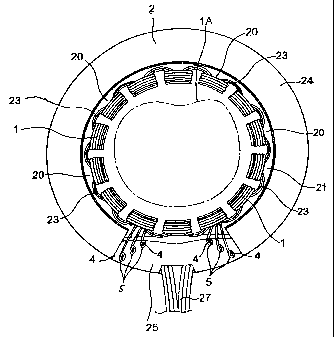Some of the information on this Web page has been provided by external sources. The Government of Canada is not responsible for the accuracy, reliability or currency of the information supplied by external sources. Users wishing to rely upon this information should consult directly with the source of the information. Content provided by external sources is not subject to official languages, privacy and accessibility requirements.
Any discrepancies in the text and image of the Claims and Abstract are due to differing posting times. Text of the Claims and Abstract are posted:
| (12) Patent: | (11) CA 2390208 |
|---|---|
| (54) English Title: | TERMINAL CONNECTION STRUCTURE OF A RESOLVER STATOR COIL |
| (54) French Title: | STRUCTURE DE RACCORDEMENT TERMINAL D'UN ENROULEMENT STATORIQUE DE RESOLVEUR |
| Status: | Expired and beyond the Period of Reversal |
| (51) International Patent Classification (IPC): |
|
|---|---|
| (72) Inventors : |
|
| (73) Owners : |
|
| (71) Applicants : |
|
| (74) Agent: | MARKS & CLERK |
| (74) Associate agent: | |
| (45) Issued: | 2006-04-04 |
| (22) Filed Date: | 2002-07-02 |
| (41) Open to Public Inspection: | 2003-01-05 |
| Examination requested: | 2002-07-02 |
| Availability of licence: | N/A |
| Dedicated to the Public: | N/A |
| (25) Language of filing: | English |
| Patent Cooperation Treaty (PCT): | No |
|---|
| (30) Application Priority Data: | ||||||
|---|---|---|---|---|---|---|
|
Disclosed is a terminal connection structure of a resolver
stator coil in which a part of the end portion of the stator coil
is left as a free end portion which is free with respect to the
terminals, whereby external impact is absorbed, and rupture of the
stator coil is prevented, thereby achieving an improvement in
reliability. An end portion (30) of a stator coil (1) is wound
around terminals (4) to form a winding connection portion (5), and
a part of the end portion (3) is left as a free end portion (30)
which is not integrally connected to the terminals (4) by soldering
or fusing, whereby a spring function is obtained.
Note: Claims are shown in the official language in which they were submitted.
Note: Descriptions are shown in the official language in which they were submitted.

2024-08-01:As part of the Next Generation Patents (NGP) transition, the Canadian Patents Database (CPD) now contains a more detailed Event History, which replicates the Event Log of our new back-office solution.
Please note that "Inactive:" events refers to events no longer in use in our new back-office solution.
For a clearer understanding of the status of the application/patent presented on this page, the site Disclaimer , as well as the definitions for Patent , Event History , Maintenance Fee and Payment History should be consulted.
| Description | Date |
|---|---|
| Time Limit for Reversal Expired | 2010-07-02 |
| Letter Sent | 2009-07-02 |
| Grant by Issuance | 2006-04-04 |
| Inactive: Cover page published | 2006-04-03 |
| Inactive: IPC from MCD | 2006-03-12 |
| Inactive: Correspondence - Prosecution | 2006-01-17 |
| Pre-grant | 2006-01-17 |
| Inactive: Final fee received | 2006-01-17 |
| Letter Sent | 2005-09-27 |
| Notice of Allowance is Issued | 2005-09-27 |
| Notice of Allowance is Issued | 2005-09-27 |
| Inactive: IPC assigned | 2005-08-18 |
| Inactive: Approved for allowance (AFA) | 2005-06-16 |
| Amendment Received - Voluntary Amendment | 2005-04-15 |
| Inactive: S.30(2) Rules - Examiner requisition | 2005-04-04 |
| Inactive: Office letter | 2005-03-01 |
| Inactive: Delete abandonment | 2004-12-02 |
| Inactive: Delete abandonment | 2004-12-02 |
| Inactive: Abandoned - No reply to s.30(2) Rules requisition | 2004-09-17 |
| Inactive: Abandoned - No reply to s.29 Rules requisition | 2004-09-17 |
| Inactive: Correspondence - Prosecution | 2004-09-16 |
| Amendment Received - Voluntary Amendment | 2004-09-16 |
| Inactive: S.30(2) Rules - Examiner requisition | 2004-03-17 |
| Inactive: S.29 Rules - Examiner requisition | 2004-03-17 |
| Application Published (Open to Public Inspection) | 2003-01-05 |
| Inactive: Cover page published | 2003-01-05 |
| Inactive: First IPC assigned | 2002-09-10 |
| Inactive: IPC assigned | 2002-09-10 |
| Inactive: IPC assigned | 2002-09-10 |
| Inactive: IPC assigned | 2002-09-10 |
| Letter Sent | 2002-07-30 |
| Filing Requirements Determined Compliant | 2002-07-30 |
| Inactive: Filing certificate - RFE (English) | 2002-07-30 |
| Letter Sent | 2002-07-29 |
| Application Received - Regular National | 2002-07-29 |
| Request for Examination Requirements Determined Compliant | 2002-07-02 |
| All Requirements for Examination Determined Compliant | 2002-07-02 |
There is no abandonment history.
The last payment was received on 2005-05-31
Note : If the full payment has not been received on or before the date indicated, a further fee may be required which may be one of the following
Please refer to the CIPO Patent Fees web page to see all current fee amounts.
| Fee Type | Anniversary Year | Due Date | Paid Date |
|---|---|---|---|
| Request for examination - standard | 2002-07-02 | ||
| Registration of a document | 2002-07-02 | ||
| Application fee - standard | 2002-07-02 | ||
| MF (application, 2nd anniv.) - standard | 02 | 2004-07-02 | 2004-05-07 |
| MF (application, 3rd anniv.) - standard | 03 | 2005-07-04 | 2005-05-31 |
| Final fee - standard | 2006-01-17 | ||
| MF (patent, 4th anniv.) - standard | 2006-07-03 | 2006-06-02 | |
| MF (patent, 5th anniv.) - standard | 2007-07-02 | 2007-06-07 | |
| MF (patent, 6th anniv.) - standard | 2008-07-02 | 2008-05-29 |
Note: Records showing the ownership history in alphabetical order.
| Current Owners on Record |
|---|
| TAMAGAWA SEIKI KABUSHIKI KAISHA |
| Past Owners on Record |
|---|
| HISASHI MIMURA |